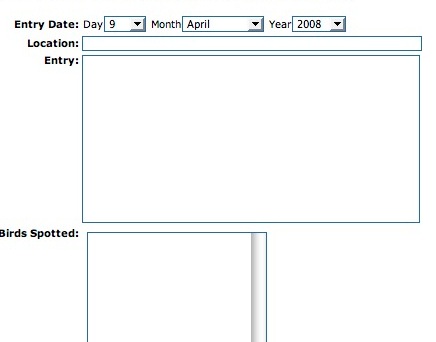Skip over navigation

So many things that we look at in Maths have a regular steady pattern that we can find and explain. For a change, let's look at things that happen more randomly.
We sometimes throw dice, toss a coin or use a rhyme to choose something at random. In this problem, we'll have a look at something a bit different - birds in the garden.
So, let's do some bird watching in our garden - at home or at school. People who do a lot of bird watching keep a chart to record which birds visit their gardens. The chart might look like this:

You might want to use a similar chart over a period of, for example, a week. Or you could just do it for one day and note the time.
Once you have a few items recorded, it would be good to have a discussion about the information you have recorded and to ask yourself some questions about it.
How many birds of a particular type did you record on each day (or each hour)?
Did you see the same type of birds at specific times of the day?
How may different types of birds did you see each day (or each hour)?
You will be able to think of many other questions too.
Are you able to see any patterns in the information you collected or do the sightings of birds appear to be quite random?
If you do find any patterns, can you try to explain why, or at least have an idea of the reason?



Or search by topic
Number and algebra
Geometry and measure
Probability and statistics
Working mathematically
Advanced mathematics
For younger learners
Birds in the Garden
Age 5 to 11
Challenge Level 






So many things that we look at in Maths have a regular steady pattern that we can find and explain. For a change, let's look at things that happen more randomly.
We sometimes throw dice, toss a coin or use a rhyme to choose something at random. In this problem, we'll have a look at something a bit different - birds in the garden.
So, let's do some bird watching in our garden - at home or at school. People who do a lot of bird watching keep a chart to record which birds visit their gardens. The chart might look like this:

You might want to use a similar chart over a period of, for example, a week. Or you could just do it for one day and note the time.
Once you have a few items recorded, it would be good to have a discussion about the information you have recorded and to ask yourself some questions about it.
How many birds of a particular type did you record on each day (or each hour)?
Did you see the same type of birds at specific times of the day?
How may different types of birds did you see each day (or each hour)?
You will be able to think of many other questions too.
Are you able to see any patterns in the information you collected or do the sightings of birds appear to be quite random?
If you do find any patterns, can you try to explain why, or at least have an idea of the reason?
You may also like
Two and One
Terry and Ali are playing a game with three balls. Is it fair that Terry wins when the middle ball is red?
Three Ball Line Up
Use the interactivity to help get a feel for this problem and to find out all the possible ways the balls could land.
Florence Nightingale - the Compassionate Mathematician
Florence Nightingale may be well known for her role as a nurse, but she was also an excellent mathematician, collecting and analysing data to help improve hospital conditions.

